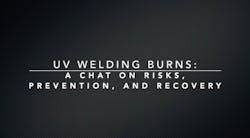Purvisha Patel, M.D., is a skin cancer surgeon, cosmetic surgeon, and general dermatologist practicing out of Memphis, Tennessee. She’s seen a significant amount of cancers due to welding, usually appearing on the fingers, hands, neck, and chest. She sat down with Gianna Annunzio, Construction Equipment's Associate Editor, to discuss the risks and prevention tips.
Skin exposed to welding UV can experience effects similar to a sunburn. It comes with the risks noted by the FDA: UVB rays have a short wavelength that reach the outer layer of your skin (the epidermis). UVA rays have a longer wavelength that can penetrate the middle layer of your skin (the dermis). Both are damaging to cell DNA.
Over periods of long-term exposure, it’s possible to develop skin cancers.
Dr. Patel says exposure is also common where clothing begins and ends—such as exposed skin on the hands where gloves cut off and sleeves begin.
“Welders get burns in these areas because heavier protective clothing gets too hot, so they tend to take it off,” Dr. Patel says. “The burn usually presents with redness, but it depends on your skin type. People with olive skin might not show any kind of redness but will receive the same amount of damage.”
Burns can also cause skin tenderness and pain. In extreme cases, blistering can also occur.
“[To protect these areas] using a physical sunscreen is also very important,” Dr. Patel says. “That’s actually going to deflect that radiation off the skin and any areas that are exposed.”
Welding also exposes the skin to various chemicals, metals, and gas fumes. According to Dr. Patel, metals such as chromium, nickel, zinc, cobalt, cambium, and tungsten, when exposed to the skin, can enhance UV sensitivity.
“[Those metals] irritate the top of the skin and make the ability to burn more likely,” she says. “If you’re welding, you’re basically breaking those things down and they [become] airborne. There are also bits of metal that can fly into the skin. If they stay in the skin, in an area with sun damage and UV radiation, we’ve seen skin cancers develop because it’s an area of chronic inflammation.”
Those metals create a “foreign body” reaction, according to Dr. Patel.
“We might even see a little piece of metal come out of the tumor,” she says. “It isn’t super common, mostly because people are taking a lot of precautions now. But it is common enough to where it needs to be recognized as a problem.”
When it comes to recovery, welders want to ensure they clean the area well to remove any metals that could have entered the skin. According to Dr. Patel, applying ice or an aloe gel to the area could help shut down the body’s inflammatory response. Seeing a board-certified dermatologist is also crucial if the skin starts to blister or bleed, she says.
Though welding skin damage is similar to a sunburn, there are several additional factors that determine how the skin will react.
“One could make an argument that welding is actually a little more dangerous, because it’s so much closer to the skin,” Dr. Patel says. “It depends on what’s being done, what body surface area is getting exposed, and for how long it’s been exposed. It also depends on skin type: how fair they are, if they’ve ever had skin cancers before, if they’ve had a history of sun damage before. That’s all going to play into how at-risk you are.”
About the Author
Gianna Annunzio
Gianna was associate editor from 2018 - 2021.
